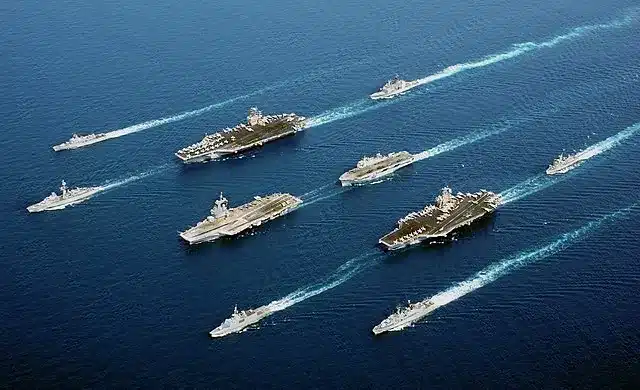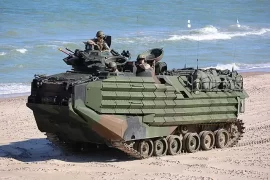Aircraft carriers stand as iconic symbols of a nation’s naval might, projecting power across oceans and shores. In the ever-evolving landscape of international security, a select group of nations stands at the forefront of aircraft carrier operations. From the sprawling decks of the United States to the distant waters of Thailand, these countries wield these maritime giants to assert influence, ensure defense, and uphold strategic interests. In this comprehensive exploration, we journey through the aircraft carrier fleets of thirteen nations, uncovering their capabilities and roles in the complex theater of global maritime security.
How Many Aircraft Carriers Does Each Country Have?
Aircraft carriers serve as the cornerstone of modern naval power projection. Currently, the United States leads with a fleet of 11 carriers, followed by China with 3 and India, the United Kingdom, Italy, and Japan with 2 each. Other nations like Russia, France, Spain, Turkey, Brazil and Thailand possess 1 each. These vessels have a rich history, dating back to the early 20th century. The first true aircraft carrier was the HMS Furious, commissioned in 1917. Since then, carriers have revolutionized naval warfare, enabling rapid global mobility and air superiority. Their strategic significance remains vital in today’s dynamic geopolitical landscape.
| Country | Number of Aircraft Carriers |
| United States | 11 |
| China | 3 |
| India | 2 |
| United Kingdom | 2 |
| Italy | 2 |
| Japan | 2 |
| Russia | 1 |
| France | 1 |
| Turkey | 1 |
| Spain | 1 |
| Brazil | 1 |
| Thailand | 1 |
| Total | 28 |
1. United States
Carriers: Nimitz-class, Ford-class
The United States boasts the world’s most formidable aircraft carrier fleet, exemplified by the Nimitz and Ford-class carriers. Currently the country operate a fleet of 11 aircraft carriers. At present, the USS Gerald R. Ford is the biggest aircraft in the world.
These giants of the sea serve as the linchpin of U.S. naval supremacy, projecting power across the globe with advanced technology, robust air wings, and unparalleled strategic reach.
2. China
Carriers: Liaoning, Shandong, Type 003
China’s emergence as a naval power is symbolized by its growing carrier fleet. The Liaoning, Shandong, and the upcoming Type 003 CNS Fujian underscore China’s commitment to maritime influence, while also revealing its aspiration to secure regional dominance in the Indo-Pacific. China is also planning to build a fourth aircraft carrier known as Type 004 aircraft carrier.
3. India
Carriers: INS Vikramaditya, INS Vikrant
India’s aircraft carriers, including the indigenous INS Vikrant, underscore the nation’s maritime strategy in a region of increasing significance. These carriers bolster India’s defense capabilities and provide a platform for power projection in the Indian Ocean.
4. United Kingdom
Carriers: HMS Queen Elizabeth, HMS Prince of Wales
The Royal Navy‘s HMS Queen Elizabeth and HMS Prince of Wales are the United Kingdom’s pride. These colossal carriers signal the UK’s dedication to maintaining a global naval presence and projecting power in defense of its interests.
5. Italy
Carriers: Giuseppe Garibaldi, Cavour
Italy’s carriers, Giuseppe Garibaldi and Cavour, offer a unique blend of amphibious assault capabilities and air power projection. These versatile platforms underscore Italy’s capacity for maritime influence and rapid response operations.
6. Japan
Carriers: Izumo, Kaga (converted for F-35B operations)
Japan’s transformation from pacifism to embracing aircraft carriers as defensive tools highlights the nation’s evolving security priorities. The Izumo and Kaga carriers, retrofitted for F-35B operations, signify Japan’s commitment to regional stability.
7. Russia
Carrier: Admiral Kuznetsov
Russia’s Admiral Kuznetsov, though aging and challenged by maintenance issues, remains a potent symbol of Russian maritime resurgence. This unique carrier serves as a projection of power and a representation of Russia’s naval ambitions on the global stage. It is a mix of aircraft carrier and guided-missile cruiser. Currently, the aircraft carrier is going through a modernization overhaul.
8. France
Carrier: Charles de Gaulle
France’s Charles de Gaulle, a nuclear-powered carrier, stands as a testament to French naval prowess. Its combat history, flexibility, and role in international operations exemplify its significance not just to France, but also to global maritime security.
9. Turkey
Carrier: TCG Anadolu (potential F-35B operations)
Turkey’s TCG Anadolu represents the nation’s aspirations for regional maritime dominance. With potential F-35B operations, this carrier reflects Turkey’s ambition to project power and safeguard its interests in a dynamic geopolitical landscape.
10. Spain
Carrier: Juan Carlos I
Spain’s Juan Carlos I, a versatile amphibious carrier, symbolizes the nation’s commitment to naval readiness and rapid response capabilities. Its potential for air operations underscores Spain’s role in regional security.
11. Brazil
Carrier: Atlantico
Brazil’s Atlantico, transformed from the HMS Ocean, signifies South America’s entry into the aircraft carrier realm. This multi-purpose carrier underscores Brazil’s ambition to establish a maritime presence in a global context.
12. Thailand
Carrier: HTMS Chakri Narubet
Thailand’s HTMS Chakri Narubet, while compact, reflects the nation’s unique maritime contributions. Its potential for revitalization underscores Thailand’s aspiration to play a role in regional security.
Summary of ‘Aircraft Carriers by Nation’
In conclusion, these twelve nations wield aircraft carriers as tools of influence, deterrence, and defense. From the technologically advanced carriers of the United States to the emerging fleets of nations like China and India, each carrier fleet represents a thread in the fabric of global maritime stability and power projection. As these giants of the sea navigate international waters, they underscore the strategic significance of maritime forces in shaping the course of geopolitics.








